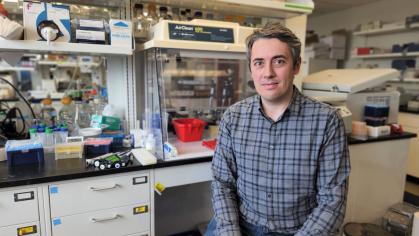Rutgers Scientist Who Researches the Sense of Smell Named Rita Allen Foundation Scholar

Kevin Monahan will use award to extend his research into spinal cord injuries
Before the COVID-19 pandemic – when losing the sense of smell and taste became a common sign of infection – Kevin Monahan says most people took smell for granted.
“Smell has really been underappreciated,” said Monahan, an assistant professor in the Department of Molecular Biology and Biochemistry in the School of Arts and Sciences at Rutgers University-New Brunswick. His research into our sense of smell earned him recognition as a 2022 Rita Allen Foundation Scholar.
“It was not the focus of our attention like hearing and vision until COVID took the sense of smell and taste away from people and they realized how important it was to them,” he said.
He is one of five scholars to earn this year’s award for early-career leaders in biomedical sciences whose research holds exceptional promise for revealing new pathways to advance human health. He joins a distinguished group of honorees who have made fundamental contributions to their fields and historically gone on to earn some of the most prestigious honors including the Nobel prize.
Monahan understands the importance of smell: the aroma of fresh-baked brownies that can bring back a pleasant childhood memory or the stink of garbage on a New York City Street that will turn the same nose up in disgust. He has spent years researching smell on the molecular level.
At Rutgers, the Monahan Lab studies just how the olfactory system – or sense of smell –can identify so many different scents, about one trillion for humans who have about 10 million nerve cells in their nose and 400 dedicated sense of smell genes.
While this biological interaction allows humans to smell pleasant and not-so-pleasant odors, each neuron has only one receptor that signals to the brain to identify whether it was stimulated by the smell of freshly mown grass or freshly brewed coffee.
Monahan’s research recognized by the Allen Foundation focuses on these specialized sensory cells high inside the nose that send messages to the brain to identify smell. Working with mice, his aim is to decipher the regulatory mechanism to determine how one gene is selected to stimulate the smell.
“It gets really complicated because there are hundreds of different receptors and they are in one part of the nose, not the other,” Monahan said. “There are many complexities that we are just beginning to understand.”
Monahan’s team is not only trying to identify the mechanism that makes this gene expression occur to understand the sense of smell on a molecular level more clearly, but to also to examine the implications the research may have on the nervous system in general.
“I’ve always been interested in understanding the diversity of cell types, the specialized cells that make the nervous system work and how you turn on the right genes to generate a different outcome,” Monahan said.
He and the four other scholars from Harvard, Stanford, Columbia and Brown universities will receive grants of up to $110,000 annually for five years. They have been selected to conduct innovative research on critical topics in cancer, immunology and neuroscience.
The funding will be used to continue his research on how 3D DNA structures in the nucleus of cells impact gene regulation, while developing novel molecular tools to understand and analyze brain circuits and investigate the evolution of the cerebral cortex. The cerebral cortex is responsible for language, memory, reasoning, thought, learning, decision-making, intelligence and personality.
Monahan says the funding from the Allen grant will enable him to build on what he has learned about how the brain works regarding the sense of smell and take his research on gene regulation in a new direction.
He plans to work with Victoria Abraira, an assistant professor of cell biology and neuroscience in the School of Arts and Sciences, who studies mice to understand what happens to the human spinal cord after injury, and whether the chronic pain state can change the nuclear structure of a cell.
“My lab is really interested in how different types of cells in the nervous system respond to the environment,” said Monahan. “We want to know how does an injury with chronic pain change the neurons. To deal with these injuries, we need to have a better understanding of the cells in your spinal cord to determine what is going wrong and what needs to be done to fix it.”



